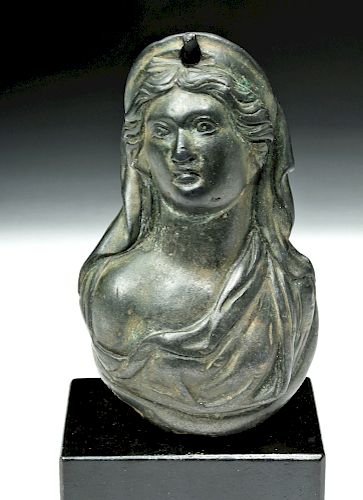Roman Bronze Steelyard Weight - Bust of A Goddess
Lot 74
About Seller
Artemis Gallery
686 S Taylor Ave, Ste 106
Louisville, CO 80027
United States
Selling antiquities, ancient and ethnographic art online since 1993, Artemis Gallery specializes in Classical Antiquities (Egyptian, Greek, Roman, Near Eastern), Asian, Pre-Columbian, African / Tribal / Oceanographic art. Our extensive inventory includes pottery, stone, metal, wood, glass and textil...Read more
Categories
Estimate:
$12,000 - $18,000
Absentee vs Live bid
Two ways to bid:
- Leave a max absentee bid and the platform will bid on your behalf up to your maximum bid during the live auction.
- Bid live during the auction and your bids will be submitted real-time to the auctioneer.
Bid Increments
| Price | Bid Increment |
|---|---|
| $0 | $25 |
| $300 | $50 |
| $1,000 | $100 |
| $2,000 | $250 |
| $5,000 | $500 |
| $10,000 | $1,000 |
| $20,000 | $2,500 |
| $50,000 | $5,000 |
| $100,000 | $10,000 |
| $200,000 | $20,000 |
About Auction
By Artemis Gallery
May 10, 2018
Set Reminder
2018-05-10 10:00:00
2018-05-10 10:00:00
America/New_York
Bidsquare
Bidsquare : Fine Ethnographic / Asian / Ancient Art
https://www.bidsquare.com/auctions/artemis-gallery/fine-ethnographic-asian-ancient-art-3213
Featuring antiquities from around the world including Pre-Columbian, Tribal, Classical, Asian, so much more! Artemis Gallery info@artemisgallery.com
Featuring antiquities from around the world including Pre-Columbian, Tribal, Classical, Asian, so much more! Artemis Gallery info@artemisgallery.com
- Lot Description
Rome, Imperial Period, ca. 30 to 50 CE. Quite a head-turner, a bronze steelyard weight cast via the lost wax (cire perdue) process depicting a goddess, most likely Juno (Hera being the Greek equivalent), wearing a veil on the back of her head (capite velato), her right shoulder bear and bust covered by a sensuously draped chiton - cast over a round stone. Total weight: 755 grams Size: 2.75" W x 4" H (7 cm x 10.2 cm); 4.5" H (11.4 cm) on included custom stand.
The beautiful goddess is depicted with her head ever so slightly tipped to the right, her attractive coiffure parted at the center and swept back along the contours of her diadem, the wavy locks meticulously delineated and arranged to frame her elegant, oval face that is sensitively modeled so as to present a naturalistic visage with a rounded forehead, large and generously lidded almond-shaped eyes, a fine browline that arches gracefully and merges with the bridge of her nose, a soft rounded chin, and full, bow-shaped, pursed lips.
In Roman mythology the ancient Roman goddess Juno, the queen of the gods, protector and special counselor to the state, and goddess of the sky and the stars, was said to have created the peacock from Argus whose hundred eyes seen on the tailfeathers of the peacock symbolize the vault of heaven and the "eyes" of the stars.
Cf. W.R. Megow, "Cameos from Augustus to Alexander Severus", 1987, pl. 7 D 13 - D 18. Cf. "The Ludovisi Juno", considered to be a portrait of Antonia Minor. Cf. K.Dahmen, "Investigations in Form and Function of Small Portraits of the Roman Imperial Period", 2001, cats.77 & 78.
Provenance: ex-Austrian collection; Gorny & Mosch, June 2007
All items legal to buy/sell under U.S. Statute covering cultural patrimony Code 2600, CHAPTER 14, and are guaranteed to be as described or your money back.
A Certificate of Authenticity will accompany all winning bids.
We ship worldwide and handle all shipping in-house for your convenience.
#127489Very fine. Some wear/loss to lower periphery of bronze image. Perforated through diadem. Attached stone weight shows expected abraded surface. Stunning rich green patina.Condition
- Shipping Info
-
All shipping is handled in-house for your convenience. Your invoice from Artemis Gallery will include shipping calculation instructions. If in doubt, please inquire BEFORE bidding for estimated shipping costs for individual items.
-
- Buyer's Premium



 EUR
EUR CAD
CAD AUD
AUD GBP
GBP MXN
MXN HKD
HKD CNY
CNY MYR
MYR SEK
SEK SGD
SGD CHF
CHF THB
THB














